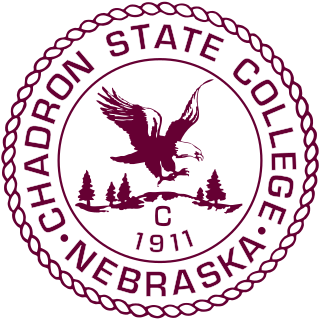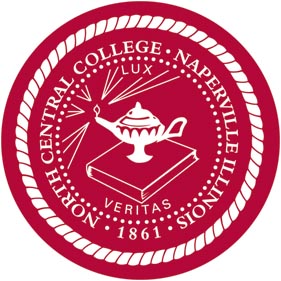
Kansas State University is a public land-grant research university with its main campus in Manhattan, Kansas. It was opened as the state's land-grant college in 1863 and was the first public institution of higher learning in the state of Kansas. It had a record high enrollment of 24,766 students for the Fall 2014 semester.

The University of Northern Iowa (UNI) is a public university in Cedar Falls, Iowa, United States. UNI offers more than 90 majors across five colleges. The fall 2023 total enrollment was 9,021 students.

The University of Missouri–Kansas City is a public research university in Kansas City, Missouri. UMKC is part of the University of Missouri System and has a medical school. As of 2020, the university's enrollment exceeded 16,000 students. It is the largest university and third largest college in the Kansas City metropolitan area. It is classified among "R2: Doctoral Universities – High research activity".

Chadron State College (CSC) is a public college in Chadron, Nebraska. It is one of three public colleges in the Nebraska State College System. It practices open admissions.

Truman State University is a public university in Kirksville, Missouri. It had 3,960 enrolled students in the fall of 2022 pursuing degrees in 55 undergraduate and twelve graduate programs.

Northern Illinois University (NIU) is a public research university in DeKalb, Illinois. It was founded as Northern Illinois State Normal School in 1895 by Illinois Governor John P. Altgeld to provide the state with college-educated teachers. In addition to the main campus in DeKalb, it has satellite centers in Chicago, Naperville, Rockford, and Oregon, Illinois.

North Central College is a private college in Naperville, Illinois. It is affiliated with the United Methodist Church and has nearly 70 areas of study in undergraduate majors, minors, and programs through 19 academic departments organized in three undergraduate colleges/schools and a masters program.

The University of Nebraska at Kearney (UNK) is a campus of the public University of Nebraska system and located in Kearney, Nebraska. It was founded in 1905 as the Nebraska State Normal School at Kearney.

Missouri Southern State University is a public university in Joplin, Missouri. It was established in 1937 as Joplin Junior College. The university enrolled 4,346 students in Fall 2021.

Ahearn Field House is one of the athletic buildings on the campus of Kansas State University in Manhattan, Kansas. It is the former home of the Wildcats men's basketball and volleyball teams and is currently home to the indoor track and field squad. It also houses facilities for the Department of Kinesiology and the Department of Intercollegiate Athletics.

Anderson Hall is the central administration building for Kansas State University in the city of Manhattan, Kansas, United States. Designed by Erasmus T. Carr, it was originally called the Practical Agriculture Building when the first wing was completed in 1879. In 1902, it was renamed "Anderson Hall" in honor of John Alexander Anderson, the second president of Kansas State Agricultural College. The building was added to the National Register of Historic Places in 1980.

KSDB-FM is Kansas State University's campus radio station. A non-commercial radio station located in Manhattan, Kansas, broadcasting on 91.9 MHz on the FM dial, KSDB is staffed by about 100 student volunteers who gain valuable experience in all areas of radio broadcasting. It plays alternative/independent rock, hip hop, and jazz and is under the jurisdiction of the A.Q. Miller School of Journalism and Mass Communications.

Marywood University is a private Catholic university in Scranton, Pennsylvania. Established in 1915 by the Sisters, Servants of the Immaculate Heart of Mary, Marywood currently enrolls more than 2,800 students in a variety of undergraduate, graduate, and doctoral programs. The university has a national arboretum with more than 100 types of trees and shrubs.

Kathryn Chicone Ustler Hall is a historic building on the campus of the University of Florida (UF) in Gainesville, Florida. It was designed by William Augustus Edwards in the Collegiate Gothic style and opened in 1919 as the University Gymnasium. In that capacity, the building was the first home of the Florida Gators men's basketball team, and it continued to serve as the home court for most of the university's indoor sports programs until the Florida Gymnasium opened in the late 1940s. The university became co-educational at about the same time, and the building was rechristened the Women's Gymnasium and was repurposed as a recreation center for the school's many new female students. On June 27, 1979, it was added to the U.S. National Register of Historic Places.

The Kansas State University Marching Band, also known as "The Pride of Wildcat Land" or just The Pride, is a 400+ piece marching band consisting of woodwinds, brass, percussion, color guard, dancers, and twirlers. It is the official band of Kansas State University.

Kennesaw State University (KSU) is a public research university in the state of Georgia with two campuses in the Atlanta metropolitan area, one in Kennesaw and the other in Marietta on a combined 581 acres (235 ha) of land. The school was founded in 1963 by the Georgia Board of Regents using local bonds and a federal space-grant during a time of major Georgia economic expansion after World War II. KSU also holds classes at the Cobb Galleria Centre, Dalton State College, and in Paulding County (Dallas). The total enrollment exceeds 45,000 students making KSU the third-largest university by enrollment in Georgia.
The Kansas State University Carl R. Ice College of Engineering offers 12 undergraduate majors and one undecided program, as well as multiple minors, and graduate programs of study. The undergraduate engineering program is ranked among the top 100 engineering schools in the United States.
KKSU was an AM radio station in Manhattan, Kansas, that broadcast from 1924 to 2002. The station was owned by Kansas State University (KSU) and operated by K-State Research and Extension, with studios and transmitter on KSU's campus in Manhattan. At the time it ended operations, it was one-half of one of the last shared-time frequencies in the United States.

Wills Gymnasium, often referred to as Wills Gym, was a multi-purpose athletic facility on the campus of Kent State University in Kent, Ohio, United States. Construction started in 1924 and the building was dedicated in 1925. It was the first dedicated gymnasium on the KSU campus, which had opened in 1913. Before the opening of Wills Gym, physical education classes and the intercollegiate and intramural sports teams used a variety of spaces for games and classes, both on campus in other buildings and off campus. The main gym seated approximately 4,000 people and the basement level included an indoor pool, locker rooms, and bowling alley. At the time, its capacity made it one of the largest facilities in the region. The building served as the primary home of the university's athletic teams and physical education department until 1950, when the Men's Physical Education Building opened. Wills Gym was the first permanent home of the Kent State Golden Flashes men's basketball team, and was also the original home venue for wrestling, men's swimming, men's and women's gymnastics, women's volleyball, and women's basketball.



















